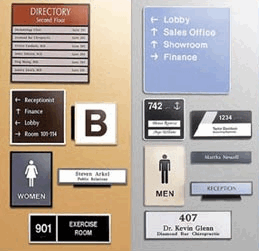Checking Out the Secret Functions of ADA Signs for Enhanced Availability
In the world of ease of access, ADA indicators serve as silent yet effective allies, ensuring that areas are inclusive and accessible for individuals with handicaps. By incorporating Braille and responsive aspects, these signs damage barriers for the visually damaged, while high-contrast shade schemes and clear typefaces provide to diverse visual requirements.
Importance of ADA Compliance
Making sure conformity with the Americans with Disabilities Act (ADA) is important for cultivating inclusivity and equal access in public areas and work environments. The ADA, established in 1990, mandates that all public facilities, employers, and transportation services fit people with handicaps, ensuring they delight in the exact same legal rights and possibilities as others. Conformity with ADA criteria not just meets lawful obligations but also enhances an organization's track record by showing its dedication to variety and inclusivity.
Among the crucial facets of ADA conformity is the application of easily accessible signs. ADA indicators are made to make certain that people with specials needs can quickly navigate through spaces and structures. These indicators have to stick to details standards relating to dimension, font style, color contrast, and placement to guarantee presence and readability for all. Effectively applied ADA signs aids remove barriers that individuals with disabilities often encounter, therefore advertising their self-reliance and confidence (ADA Signs).
Furthermore, adhering to ADA guidelines can mitigate the danger of legal repercussions and potential fines. Organizations that stop working to comply with ADA guidelines might encounter fines or claims, which can be both harmful and financially challenging to their public image. Therefore, ADA compliance is essential to cultivating an equitable environment for everybody.
Braille and Tactile Components
The unification of Braille and tactile elements into ADA signage symbolizes the concepts of accessibility and inclusivity. It is commonly placed under the corresponding message on signage to ensure that individuals can access the information without aesthetic aid.
Tactile aspects expand beyond Braille and consist of raised personalities and symbols. These components are created to be discernible by touch, enabling individuals to identify room numbers, toilets, departures, and various other important areas. The ADA establishes particular standards pertaining to the size, spacing, and placement of these tactile components to maximize readability and make sure consistency throughout different atmospheres.

High-Contrast Color Pattern
High-contrast color design play a pivotal function in boosting the presence and readability of ADA signs for individuals with aesthetic disabilities. These systems are vital as they take full advantage of the distinction in light reflectance in between message and history, making sure that signs are quickly discernible, also from a range. The Americans with Disabilities Act (ADA) mandates making use of specific shade contrasts to fit those with minimal vision, making it an essential aspect of conformity.
The efficiency of high-contrast colors hinges on their ability to stand apart in different lights conditions, including poorly lit atmospheres and locations with glare. Typically, dark text on a light background or light text on a dark history is employed to achieve optimal comparison. Black message on a white or yellow history gives a plain aesthetic difference that aids in Resources quick recognition and understanding.

Legible Fonts and Text Dimension
When considering the design of ADA signs, the selection of readable fonts and ideal text dimension can not be overemphasized. The Americans with Disabilities Act (ADA) mandates that fonts must be sans-serif and not italic, oblique, manuscript, highly decorative, or of unusual type.
The size of the message also plays a pivotal function in access. According to ADA guidelines, the Find Out More minimum text elevation should be 5/8 inch, and it needs to boost proportionally with seeing range. This is especially important in public spaces where signage demands to be reviewed quickly and precisely. Consistency in text dimension adds to a cohesive visual experience, assisting individuals in navigating atmospheres effectively.
Additionally, spacing between letters and lines is important to readability. Appropriate spacing stops characters from showing up crowded, boosting readability. By adhering to these criteria, developers can considerably boost ease of access, ensuring that signage offers its intended objective for all individuals, despite their visual capacities.
Efficient Positioning Methods
Strategic positioning of ADA signs is essential for optimizing accessibility and making sure compliance with lawful standards. Effectively located signs lead individuals with disabilities successfully, facilitating navigation in public areas. Key factors to consider include distance, elevation, and visibility. ADA guidelines specify that signs need to be placed at an elevation between 48 to 60 inches from the ground to ensure they are within the line of view for both standing and seated people. check over here This common elevation variety is essential for inclusivity, enabling mobility device individuals and people of differing elevations to accessibility information effortlessly.
Additionally, indicators need to be positioned adjacent to the lock side of doors to allow very easy recognition prior to access. Consistency in indication placement throughout a center improves predictability, decreasing confusion and enhancing general user experience.

Conclusion
ADA indications play a vital role in promoting availability by incorporating attributes that resolve the demands of people with specials needs. These aspects collectively promote an inclusive environment, emphasizing the relevance of ADA conformity in making sure equal gain access to for all.
In the realm of accessibility, ADA indicators offer as quiet yet powerful allies, ensuring that rooms are comprehensive and navigable for individuals with specials needs. The ADA, passed in 1990, mandates that all public centers, companies, and transport services suit people with impairments, ensuring they enjoy the very same legal rights and opportunities as others. ADA Signs. ADA indicators are created to guarantee that individuals with handicaps can quickly navigate with buildings and rooms. ADA standards stipulate that indicators ought to be mounted at an elevation between 48 to 60 inches from the ground to guarantee they are within the line of sight for both standing and seated people.ADA signs play an essential function in advertising availability by integrating attributes that deal with the demands of individuals with handicaps